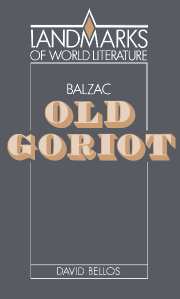2 - The achievement of Old Goriot
Published online by Cambridge University Press: 05 June 2012
Summary
The representation of social life
One of the things that Old Goriot does for many readers is to create the illusion of life. To make the reader or listener or spectator ‘suspend his disbelief’ and to enter a representation as it if were the life represented has been the aim of a long tradition of writers and artists from antiquity to the present. The history of mimesis, or representation, is told, amongst others, by Auerbach and Levin, and for both of these critics Old Goriot is a landmark in the development of modern ways of writing realistically. If Balzac does succeed in creating the illusion of real life for his reader, he does it by means that are significantly different from Victor Hugo's highly-coloured, intensely visual descriptions of medieval Paris in Notre-Dame de Paris, just as they are different from Flaubert's impersonal and impassive approach to the miseries of provincial life in Madame Bovary (1857). However, the creation of a fleeting effect of ‘lifelikeness’ is not at all rare in literature and art, and one of the more curious aspects of cultural history is to discover what past generations took to be vraisemblable or lifelike. As a young man, Balzac himself was an enthusiastic admirer even of Daguerre's old cardboard Diorama (p. 40).
Daguerre and Bouton have amazed the whole of Paris; a thousand problems are solved since in front of a canvas screen you believe you're in a church a hundred yards from each thing. It's the wonder of the age.
(Corr I.205)- Type
- Chapter
- Information
- Balzac: Old Goriot , pp. 46 - 101Publisher: Cambridge University PressPrint publication year: 1987



